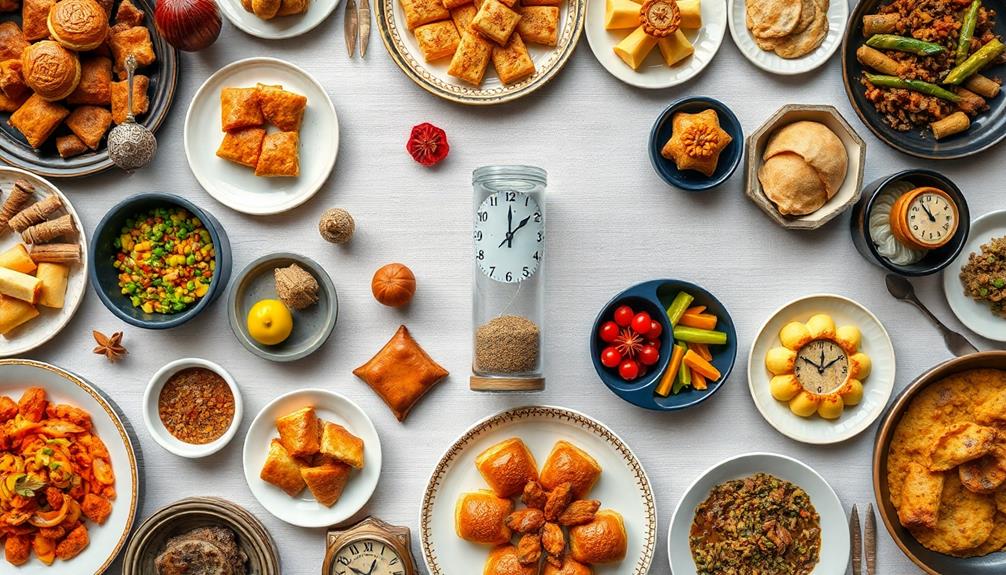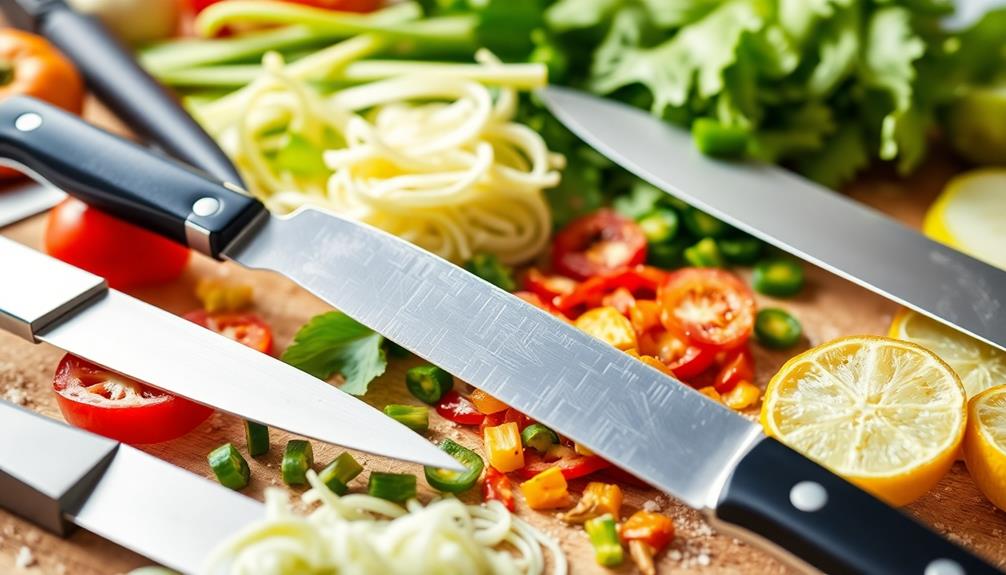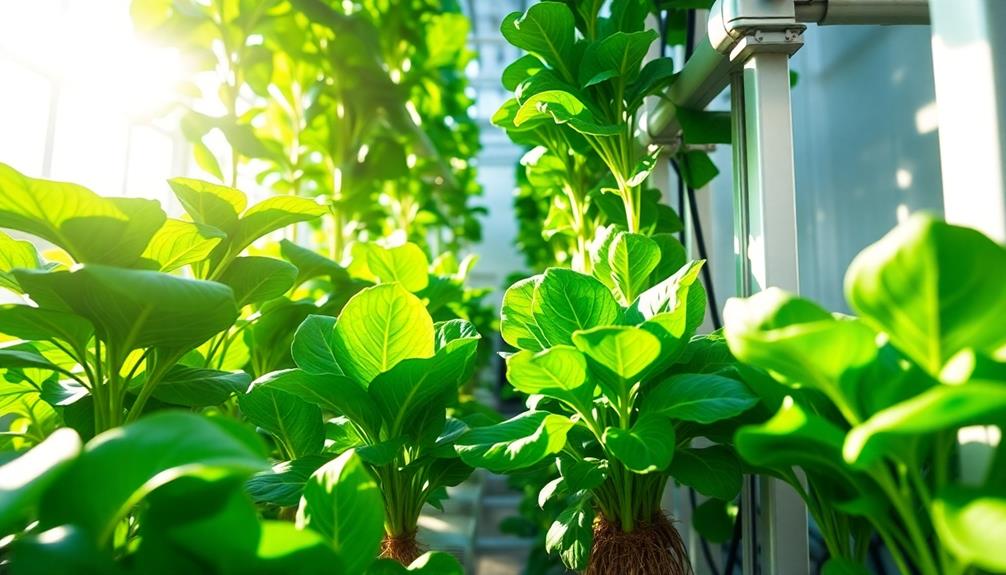Different cultures connect food practices to time measurement in fascinating ways. You might notice that meals often signify seasonal changes, like Thanksgiving in the U.S. or Japan's Mid-Autumn Festival, where specific foods represent harvest cycles. Additionally, significant life events are marked by special meals, such as rice cakes for birthdays in Japan or Passover's matzah in Jewish tradition. Communal meals, like those in Mediterranean cultures, emphasize social time and strengthen community bonds. The culinary customs surrounding these traditions guide you through the rhythms of life. There's so much more to explore about how food shapes our understanding of time!
Key Takeaways
- Food customs, like breakfast traditions, vary globally, reflecting cultural identities and daily routines tied to time measurement.
- Seasonal food celebrations, such as Thanksgiving and Tsukimi, highlight agricultural cycles and mark important community rituals.
- Specific meals are integral to life events, connecting generations and marking significant moments in cultural calendars.
- Agricultural practices influence communal events, synchronizing food consumption with seasonal changes, reinforcing social bonds and cultural heritage.
- Historical contexts, like Ramadan and ancient Egyptian offerings, illustrate how food shapes time structures and community practices.
Cultural Significance of Food Timing

Food timing plays an essential role in shaping cultural identities and daily routines across the globe. When you consider breakfast, for instance, it's a key part of morning routines in Western societies, while in many Asian cultures, breakfast might be lighter or even skipped. This difference influences how you perceive time and the importance of meals in your daily life.
In Mexico, for example, traditional breakfasts like Chilaquiles showcase how food timing can also reflect regional customs and culinary heritage. In the Mediterranean, communal meals often occur later in the evening, reflecting a slower pace and the value placed on social interaction. Here, food timing isn't just about hunger; it's tied to social status and cultural norms.
You might also notice that in agricultural societies, food preparation aligns closely with seasonal changes and harvest times, revealing how food practices mirror the rhythms of nature. Additionally, cultural beliefs, like fasting during Ramadan, show how food timing intertwines with spiritual practices, marking important moments in religious observance.
All of this highlights the cultural significance of food timing, emphasizing that what you eat and when you eat it can reflect much more than just nourishment; it's a crucial expression of identity and community across cultures.
Seasonal Foods and Celebrations
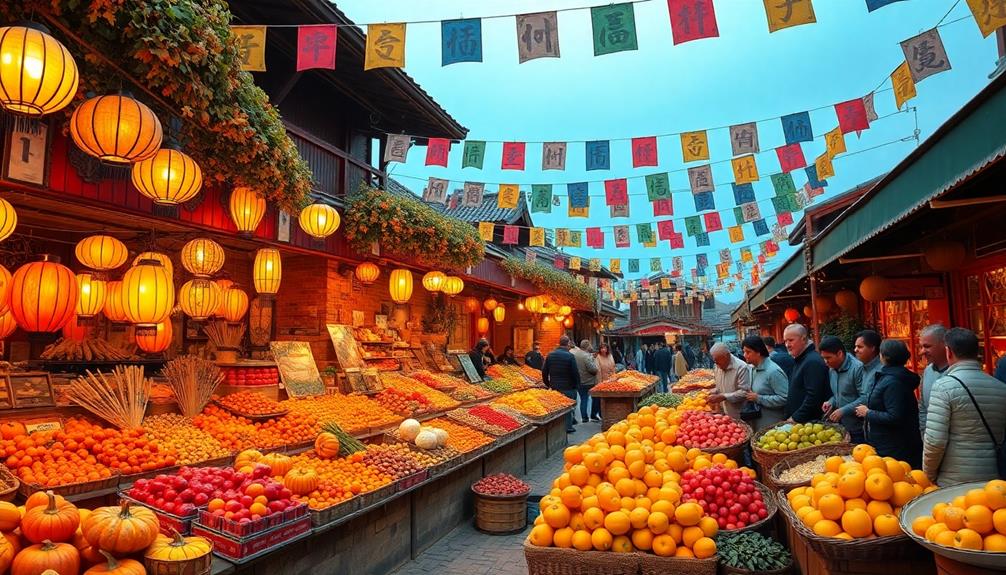
When you think about seasonal foods, it's fascinating how many cultures celebrate harvest festivals with unique dishes that reflect their agricultural traditions.
For instance, dishes like Nettle and Potato Soup highlight the seasonal bounty and nutritional benefits of local ingredients.
These celebrations not only mark the changing seasons but also showcase the importance of seasonal ingredients in their cuisines.
Understanding these food customs helps you appreciate how they connect communities and honor the cycles of nature.
Harvest Festivals Significance
Harvest festivals, celebrated in numerous cultures around the world, serve as essential markers of the agricultural year and highlight the importance of seasonal foods. These festivities often coincide with the gathering of crops, showing gratitude for what the earth has provided. In the U.S., Thanksgiving brings families together over pumpkins and cranberries, while Japan's Tsukimi showcases rice and chestnuts during the Moon Viewing Festival.
These harvest festivals create a natural calendar for communities, defining their cultural rhythms and identity through food. Each festival includes traditional rituals, dances, and feasts that celebrate local produce and agricultural knowledge.
| Festival | Country | Seasonal Foods |
|---|---|---|
| Thanksgiving | United States | Pumpkins, Cranberries |
| Tsukimi | Japan | Rice, Chestnuts |
| Pongal | India | Rice, Jaggery |
| Mid-Autumn Festival | China | Mooncakes, Fruits |
These celebrations not only foster community bonds but also guarantee the transmission of agricultural practices to future generations, making harvest festivals a significant aspect of cultural heritage.
Seasonal Ingredients Traditions
Celebrations around the world often center on seasonal ingredients that reflect local agricultural cycles and traditions.
In Japan, as spring arrives, you might find yourself enjoying sakura-themed dishes, celebrating the cherry blossoms in full bloom, alongside seasonal treats like Dorayaki (Red Bean Pancake) that highlight the culture's affinity for sweet flavors.
Similarly, in India, Makar Sankranti marks the harvest season, where you can savor til sweets that symbolize prosperity.
Traveling to Mexico, you'll encounter the Day of the Dead (Día de los Muertos), where traditional foods like pan de muerto are prepared specifically for the occasion, highlighting the seasonal cycle of life and death.
If you're in China during the New Year, you'll likely indulge in dumplings and fish, both symbols of wealth and abundance, prepared in accordance with the lunar calendar.
In Scandinavian countries, the onset of winter is celebrated with festive foods such as lutefisk and glögg, showcasing the significance of seasonal ingredients in cultural celebrations.
These food traditions not only connect you to the cycles of nature but also foster a sense of community and continuity, allowing you to honor your heritage while enjoying the flavors of each season.
Rituals Marking Life Events
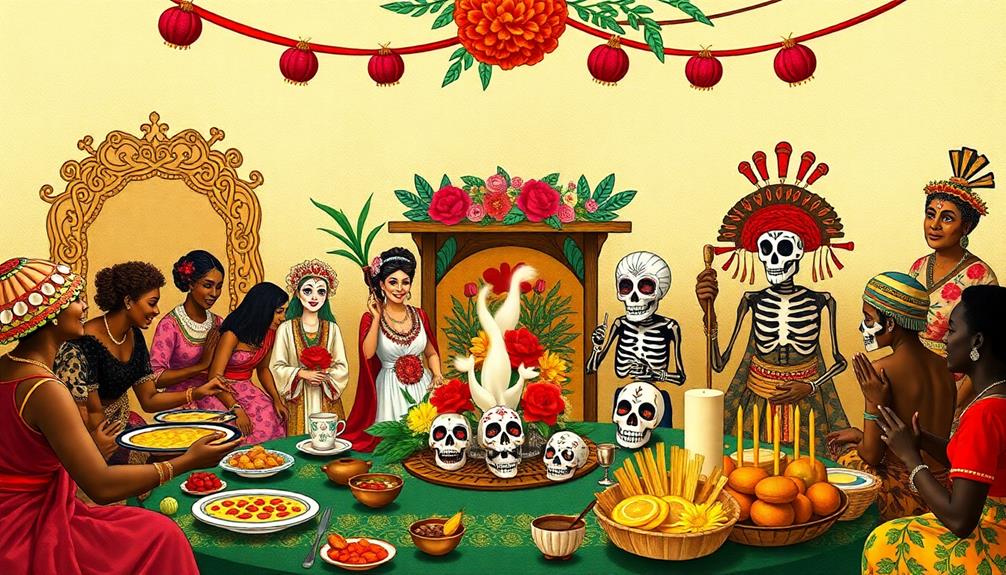
Food plays an essential role in rituals marking significant life events across various cultures, bringing people together in meaningful ways. These rituals often revolve around communal nourishment, highlighting the importance of shared meals during changes like weddings, births, and funerals.
In Japanese culture, the "Shichi-Go-San" celebration incorporates rice cakes, symbolizing growth and the passage of time for children. Similarly, during the Jewish Passover Seder, breaking bread serves as a reminder of the Exodus, connecting generations through food and history.
Vietnamese funerals illustrate how food honors the deceased while reinforcing social bonds. Elaborate meals create a space for remembrance and reflection, emphasizing the role of community in managing loss.
Many Indigenous cultures celebrate seasonal feasts that mark harvest cycles and significant alterations in nature. These gatherings not only provide sustenance but also link food practices to the rhythms of the environment, showcasing the interconnectedness of life events and the passage of time.
In each of these examples, food transcends mere sustenance; it becomes a crucial part of the rituals that shape our understanding of life's milestones and cultural continuity.
Food and Agricultural Cycles
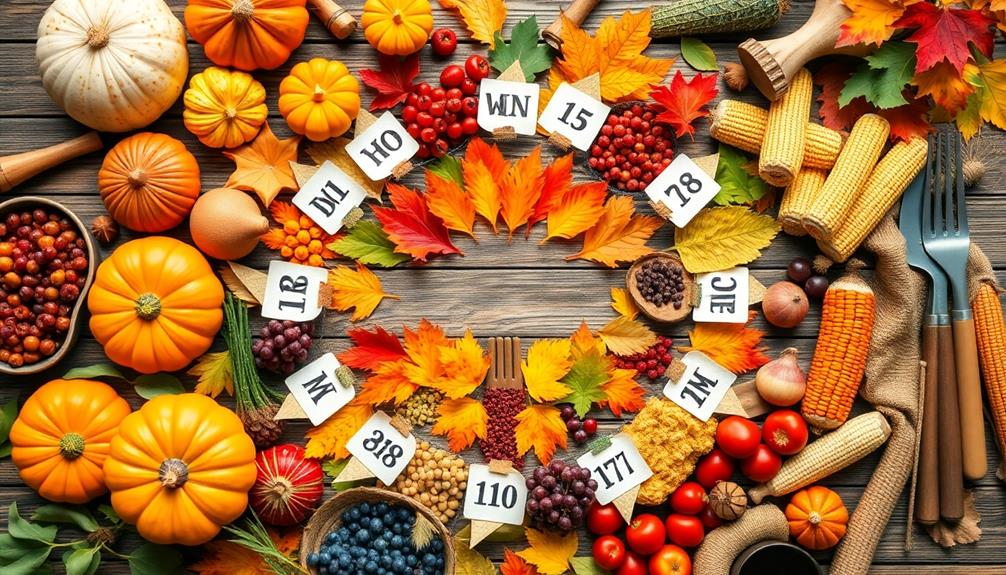
When you think about food, consider how agricultural cycles shape your understanding of time.
Seasonal harvests often signal important rituals and festivities, marking shifts in your community.
These moments not only celebrate the bounty of the land but also deepen your connection to cultural traditions.
Seasonal Harvest Significance
Throughout history, various cultures have intertwined the rhythms of their agricultural cycles with the measurement of time, creating a unique framework for understanding the seasons.
You'll find that many societies rely on seasonal harvest cycles to mark the passage of time. These cycles not only dictate when crops are planted and harvested but also shape social and economic practices.
Here are four examples of how seasonal harvests influence communal celebrations:
- Japanese Taue Festival: This rice planting festival marks the beginning of the rice growing season, fostering community togetherness.
- Native American Harvest Moons: Celebrations of harvest moons signal the end of the growing season, emphasizing gratitude for the bounty.
- Chinese Mid-Autumn Festival: This festival celebrates the harvest of rice and fruits, showcasing the significance of seasonal food availability.
- Mediterranean Olive and Grape Harvests: The timing of these harvests serves as essential markers for both farming practices and local festivities.
Rituals and Festive Timing
As the seasons shift, many cultures synchronize their rituals and celebrations with the agricultural calendar, creating a rich tapestry of communal events centered around food. You'll find that these events are often marked by specific foods that reflect the harvest and seasonal changes, reinforcing community bonds.
For instance, Japan's rice planting ceremony, or "taue," in May symbolizes the start of the rice-growing season, bringing people together in shared agricultural practices.
In China, the Lunar New Year features dumplings and fish, foods that symbolize prosperity and abundance, marking a new year tied closely to agricultural cycles. Similarly, in India, festivals like Pongal honor the harvest and the Sun God with special dishes, highlighting how food environments serve as crucial markers of time.
The Maasai people of East Africa celebrate the "Olmotonyi" ceremony to signify the change from rainy to dry seasons, incorporating traditional foods that emphasize the importance of timing in their agricultural lifestyle.
These social events not only reinforce cultural identity but also remind you of the deep connections between food, community, and the rhythms of nature.
Meals as Social Time Markers
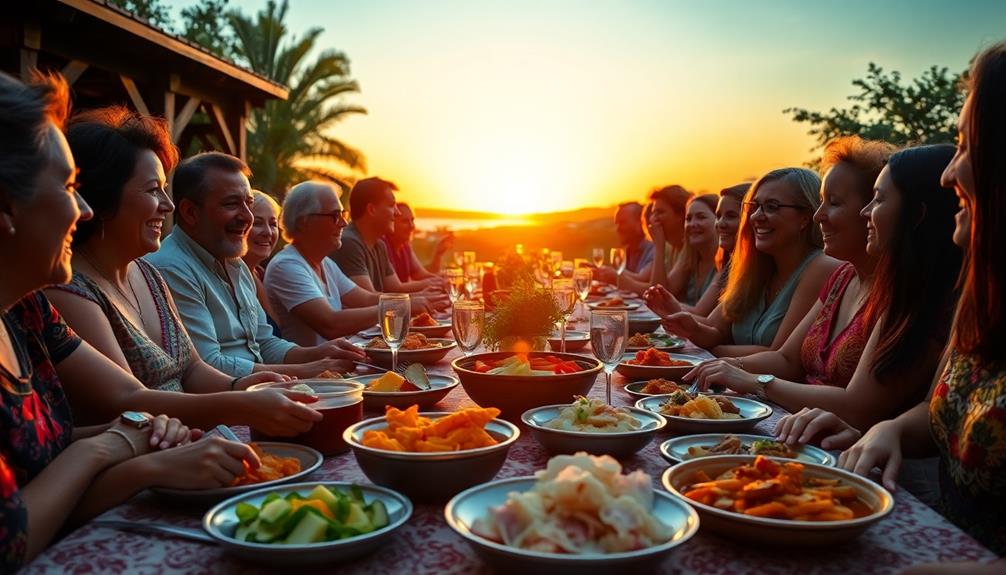
Meals often act as social time markers, shaping the rhythm of daily life in various cultures. They not only provide nourishment but also signify changes and communal bonding. Through these shared experiences, you can observe significant cultural practices that highlight the importance of communal meals.
- Mediterranean Cultures: Long, leisurely meals, like the siesta, emphasize socializing and enjoying food as a way to structure time.
- Japanese Festivals: Events like Hanami connect specific meals to seasonal celebrations, marking the passage of time throughout the year.
- Indigenous Cultures: Meals are often scheduled around natural events, such as harvests, blending timekeeping with a sense of community and environment.
- Vietnamese Traditions: Significant life events, including weddings and funerals, are marked by specific meals that reflect cultural practices and communal gatherings.
Culinary Practices in Festivals
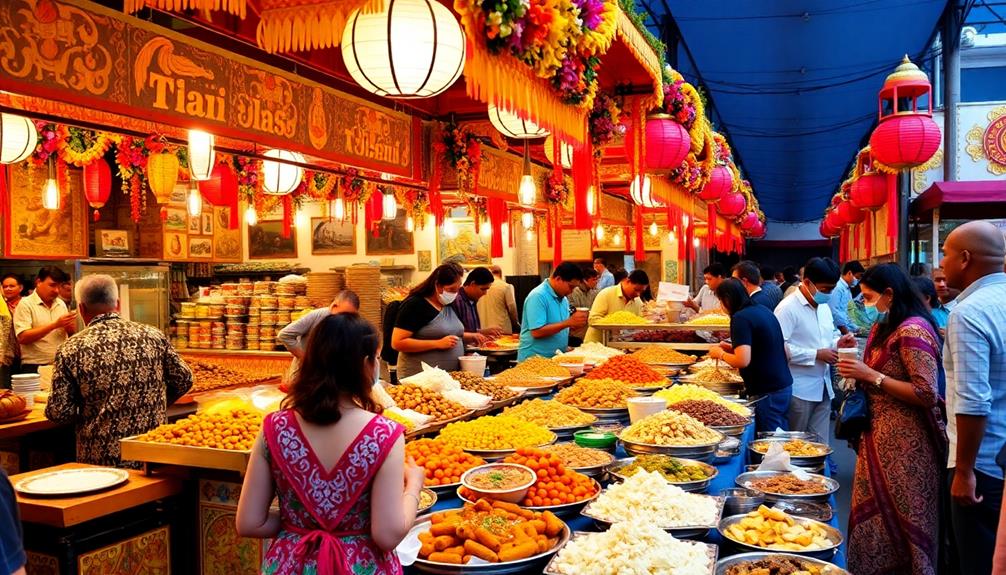
Festivals around the world showcase culinary practices that not only celebrate cultural heritage but also mark important temporal milestones.
For instance, during the Mid-Autumn Festival in China, you might enjoy mooncakes, which symbolize the harvest and family reunions, highlighting the importance of time spent together.
Similarly, in India, Diwali features sweets like ladoos and barfis that signify the joy of sharing and mark the end of the harvest season.
When you participate in the Jewish festival of Passover, matzah serves as a reminder of the Exodus, connecting you to a historical timeline of liberation.
In Mexico, the culinary practices of Día de los Muertos include sugar skulls and pan de muerto, which honor deceased loved ones and reflect the cyclical nature of life and death.
Lastly, Thanksgiving in the United States revolves around a shared meal that embodies gratitude and the seasonal harvest, reinforcing how food plays a pivotal role in marking time within the social calendar.
These culinary practices during festivals not only enrich your experience but also deepen your understanding of how diverse cultures perceive and measure time through food.
Historical Context of Food Measurement
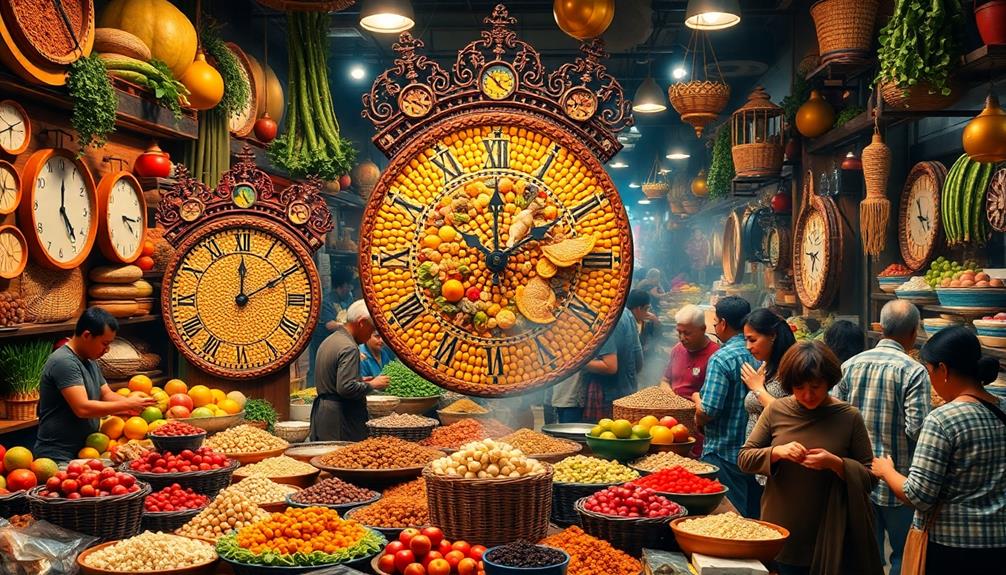
Throughout history, cultures have intricately woven food measurement into their understanding of time, often aligning culinary practices with significant events and natural cycles. By observing how food preparation marks the passage of seasons, you'll discover a rich tapestry of traditions. Here are some key examples:
- In ancient Egypt, food offerings to deities were timed with agricultural cycles, showcasing a strong link between food and time.
- The Ramadan fast establishes a unique time structure, marking days through the rhythm of food consumption from dawn to sunset.
- Many Indigenous cultures rely on the seasonal availability of food, directly influencing their calendars for hunting, gathering, and planting essential for survival.
- Japan's "ichiju-sansai" emphasizes meal timing and the use of seasonal ingredients, reflecting cultural rituals in daily life.
These practices reveal how food serves not just as sustenance but as a cultural marker of time, guiding communities through seasonal changes and significant events.
Food Preparation and Community Identity
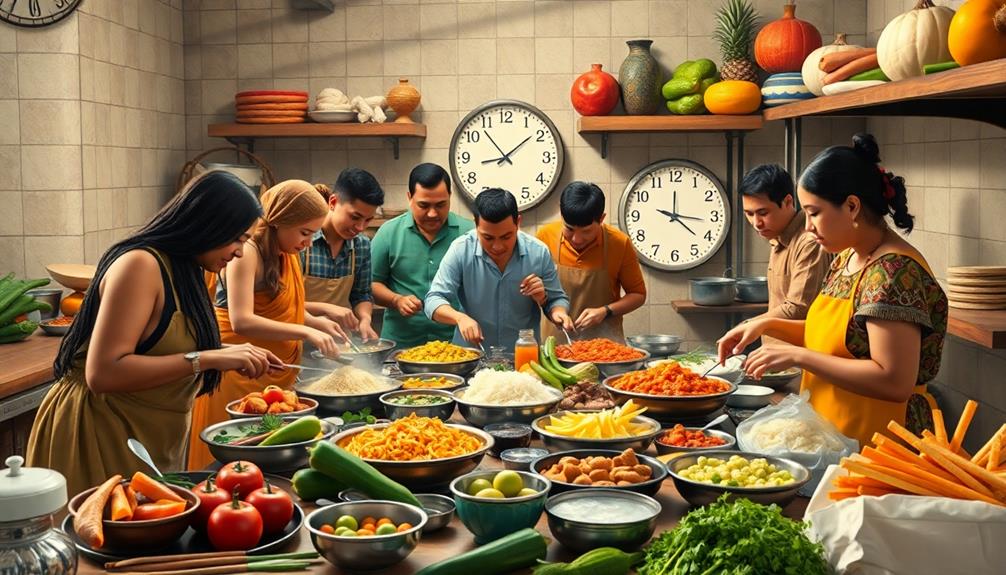
While food preparation often serves as a reflection of communal identity, it also fosters connections among individuals, reinforcing shared values and traditions. In many cultures, specific dishes are tied to cultural rituals and seasonal events, marking the passage of time within communities.
For example, when you join in the Vietnamese tradition of making banh chung during Tet, you're not just cooking; you're actively participating in a communal activity that strengthens social bonds and cultivates a sense of belonging.
Certain food items act as seasonal indicators, helping you track agricultural cycles and celebrate milestones throughout the year. Think of the joy when fruits or grains are harvested, signaling the time for festivals and gatherings.
The timing and methods of food preparation often reflect cultural values, such as the slow cooking practices in some societies, emphasizing patience and the importance of shared meals.
These communal gatherings centered around food not only preserve culinary traditions but also create shared memories that reinforce communal identities. Through food preparation, you engage with your culture, celebrating both your heritage and the connections formed with others in your community.
Global Perspectives on Time and Food
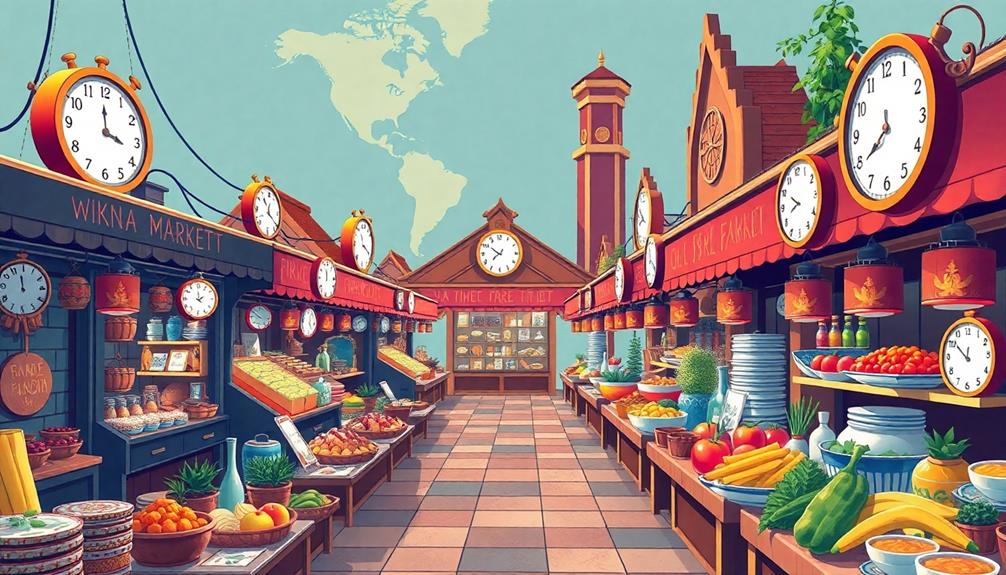
Food acts as a universal marker of time across cultures, with various celebrations and rituals highlighting its significance. You might notice how different societies use food to track important moments in their lives. Here are some key examples:
- Chinese New Year: Specific dishes symbolize luck and prosperity, marking the start of a new year.
- Indigenous Cultures: Seasonal changes are tracked through the availability of certain foods, with harvest times serving as essential calendar markers.
- Ramadan: In Islamic cultures, fasting includes meals like Suhoor and Iftar, creating a spiritual rhythm throughout the month.
- Italian Pranzo: The midday meal is a time for family gatherings, emphasizing social connections through shared food experiences.
These examples illustrate how food serves not just as sustenance but also as a cultural compass.
By celebrating special occasions or observing rituals tied to food, you engage in a rich tapestry of human experience that transcends mere nutrition.
Understanding these diverse perspectives on time and food can deepen your appreciation for cultural practices and the importance of food in marking significant moments.
Frequently Asked Questions
How Do Different Cultures Measure Time?
Different cultures measure time in unique ways. You might notice some rely on natural cycles, while others focus on events or social interactions. Understanding these differences can enrich your perspective on time and daily life.
How Is Time Represented in Different Cultures?
You notice time's representation varies globally. In some cultures, it's marked by rituals and events, while others rely on nature's cycles. Each community's unique practices shape how you understand and experience time in everyday life.
How Do Different Cultures Handle Time?
Different cultures handle time in various ways, prioritizing either strict schedules or natural rhythms. You might notice some value punctuality, while others embrace a more relaxed approach, focusing on experiences rather than minutes ticking away.
How Might Various Cultures Think of Time Differently?
Time's tapestry twists uniquely across cultures; you'll notice some prioritize punctuality while others savor spontaneity. Understanding these diverse perspectives helps you appreciate the rich rhythms of life, shaping how you interact with people and experiences.
Conclusion
In many cultures, food isn't just about sustenance; it's a way to mark time and celebrate life. For instance, did you know that around 30% of the world's population relies on seasonal foods to dictate their annual celebrations? This highlights just how intertwined food and time are in shaping traditions and community identity. By understanding these connections, you can appreciate the rich tapestry of cultures that use food as a unique measure of the passage of time.
